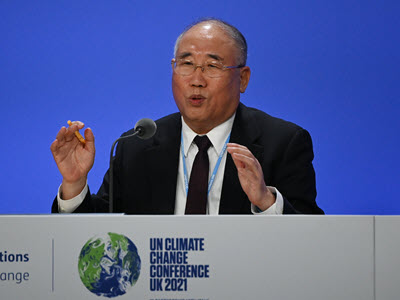Roundtable from Beyond COP26: Regional Cooperation for Climate
China and Climate Change
COP26 and Beyond
This essay by Barbara Finamore is part of the roundtable Beyond COP26: Regional Cooperation on Climate Change.
From China’s perspective, the key to tackling climate change is action. The country has put in place a series of concrete policies and measures designed to achieve its climate targets. These include a comprehensive action plan for CO2 peaking before 2030 and a high-level policy framework for achieving carbon peaking and carbon neutrality by 2060. More detailed 2030 peaking plans are on the way, covering key sectors such as energy, industry, construction, and transportation. Each province must submit an implementation plan to be approved by the central government. China has already adopted scores of policies and regulations aimed at accelerating its green transition, enabling it to become the world leader in renewable energy and electric vehicles.
Yet climate targets themselves are also critically important. China’s updated targets are not a significant improvement over its Paris pledges. They do not reflect the urgent need for enhanced ambition in this critical decade to avoid the worst consequences of climate change. Without a specific timeline and ceiling for the exact level of peaking CO2 emissions before 2030, China’s commitments are not compatible with global pathways to limit warming to 2°C, let alone 1.5°C. The country’s short-term climate targets are also insufficient to put it on track to reach carbon neutrality before 2060.
CURRENT ENERGY TRENDS
The key sticking point is coal, which is the source of 70% of China’s CO2 emissions. Although President Xi Jinping recently announced that the country will not build new coal-fired power projects abroad—a move with enormous climate benefits—he has not done the same at home. At the Leaders’ Summit on Climate in April 2021, President Xi reiterated his plan to strictly limit the increase in China’s coal consumption through 2025 and phase it down over the 15th Five-Year Plan period (2026–30). He also pledged to “rein in the irrational development of energy-intensive and high-emission projects.” But he stopped short of halting new coal projects, specifying a clear deadline for peaking coal consumption, or limiting how high that peak will be. At COP26, China and India pushed to water down the language in the Glasgow Climate Pact, replacing calls for a “phase-out” of coal power with a “phase-down.”
Granted, transforming China’s economy to one based on green and low-carbon development is an enormous undertaking. Two major challenges are helping rural communities switch to clean heating and ensuring a just transition for coal workers. But China has also missed important opportunities to boost economic growth and stability without relying on coal. Only a small fraction of its pandemic stimulus package went to green, sustainable, or low carbon-projects. Instead, local governments used much of their relief funds to build questionable energy-intensive and high-emission projects in the heavy industry and construction sectors—both top sources of CO2 emissions.
This led to a spike in emissions as well as a boom in the construction of coal plants to power these projects. In 2020, China added three times as much new coal power capacity as the rest of the world combined. Even though CO2 emissions have recently begun to drop, these new projects represent what Rocky Mountain Institute cofounder Amory Lovins calls “pre-stranded” assets, which local governments—and other vested interests—will fight to keep in operation.
A power crisis in China last fall, featuring skyrocketing coal prices and electricity rationing, also led the government to double down on coal. But much of the crisis was traced back to power sector rules that prevented coal power plants from raising rates to recover extremely high fuel costs. Subsequent reforms have raised electricity price caps to some extent. But full power sector reforms, which have been on hold for two decades, could enable China’s growing renewable energy sector to compete with coal on a level playing field.
PATHS FORWARD FOR CHINA AND THE WORLD
The Intergovernmental Panel on Climate Change reports that the world needs to cut global CO2 emissions by 45% below 2010 levels by 2030 to avoid the worst consequences of climate change. Yet even with new and existing pledges, global greenhouse gas emissions in 2030 will still be around twice as high as necessary to stay within the 1.5°C limit. As a result, the Glasgow Climate Pact calls on all countries to revisit and strengthen their 2030 targets by the end of 2022 in order to align with the Paris temperature goals.
The U.S.-China Joint Glasgow Declaration on Enhancing Climate Action in the 2020s provides an important platform for both sides to exchange experiences and explore potential policy and technical solutions. Both the United States and China are large emitters that face steep challenges in transitioning away from fossil fuels. The joint declaration calls for cooperation on a number of shared issues, such as integrating high levels of renewable energy into the grid and maximizing the societal benefits of the clean energy transition.
Ensuring China’s economic stability has always been a top priority of the central government, never more so than in the runup to the 20th Party Congress in late 2022. Providing fresh stimulus funds to carbon-intensive projects might work in the short run. However, in order to ensure long-term economic prosperity and social stability, it is essential for China’s leaders to accelerate the clean energy transition, which will limit the ever-growing damage from climate change to the country and its people. Strengthening efforts to rein in coal is the most important step.
China is one of the countries that is most vulnerable to climate change. Temperatures are already rising higher than the global average, increasing the risks to health, livelihoods, and natural resources. The damage is likely to disproportionately affect the poorest groups in society. Flooding already causes more loss and damage in China than in any other country. Melting glaciers, widespread droughts, and destructive typhoons are threatening food, water, and energy security. The Pearl River Delta, China’s manufacturing center and most densely populated region, is the world’s most at-risk urban center from rising sea levels. It could be under up to two meters of water by the year 2100, absent deep and immediate cuts in greenhouse gas emissions. It is thus essential—and in the country’s own self-interest—for China to come to COP27 with clear, ambitious, and achievable short-term climate targets.
Barbara Finamore is a Senior Visiting Research Fellow at the Oxford Institute for Energy Studies. She is a senior leader and environmental attorney with over four decades of experience in environmental law and clean energy policy. Ms. Finamore has served as a senior attorney and the senior strategic director for Asia at the Natural Resources Defense Council (NRDC), the president and chair of the Professional Association for China’s Environment (PACE), and the president of the China-U.S. Energy Innovation Alliance, which she co-founded. She holds a JD with honors from Harvard Law School.



